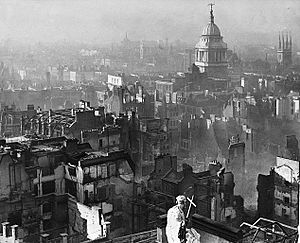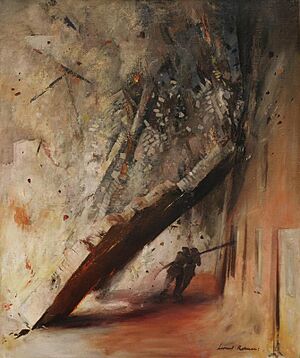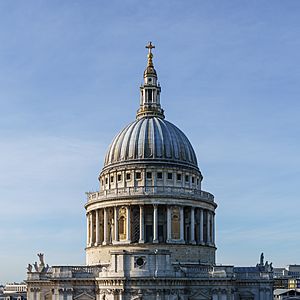Second Great Fire of London facts for kids
Quick facts for kids Second Great Fire of London |
|
|---|---|
| Part of the Blitz | |

The view from the roof of St Paul's Cathedral towards the Old Bailey after the second Great Fire of London
|
|
| Location | London, England |
| Coordinates | 51°31′N 0°05′W / 51.51°N 0.09°W |
| Date | 29–30 December 1940 6:15 pm – 4:00 am (UTC+00:00) |
| Target | City of London |
|
Attack type
|
Air raid |
| Deaths | 160 |
|
Non-fatal injuries
|
250 |
| Perpetrator | Luftwaffe |
The Second Great Fire of London happened in December 1940. It was one of the most damaging air raids during the Blitz in World War II. German planes, called the Luftwaffe, dropped bombs that caused fires over a huge area. This area was even bigger than the one affected by the Great Fire of London in 1666.
An American reporter described it by saying, "The second Great Fire of London has begun." One of the bombs, an incendiary bomb, even broke through the dome of St Paul's Cathedral. A special fire watch team was guarding the cathedral because Prime Minister Winston Churchill wanted it protected.
The Attack on London
On the night of December 29–30, 1940, about 100,000 bombs fell on London. Most of these were small incendiary bombs. The Germans sent 136 bomber planes to attack the city.
This raid focused on a part of London with many non-residential buildings. These included churches, offices, and warehouses. Many of these places were locked up. They were not covered by a rule that said workplaces with 30 or more employees needed fire watchers.
Incendiary bombs were the main weapon used that night. These bombs were fairly small, about 12 by 3 inches (30 by 7.6 cm). Each bomber plane carried around 180 of them. The bombs contained magnesium, which burns very hot and starts fires easily. During this raid, 1,500 fires began across the city.
Fighting the Fires
Firefighters faced many problems trying to put out the fires. One big issue was a shortage of water. The main water pipe in the City was broken by a bomb.
When fire units tried to get water from other hydrants, the water pressure dropped. Also, it was hard to get water from the River Thames because the tide was low. Strong winds made the fires spread even faster.
Twelve of the 160 people who died in the raid were firefighters. Another 250 firefighters were injured.
Artist Leonard Rosoman was working as a firefighter that night. He was fighting a fire in Shoe Lane. He had just handed over his hose to another firefighter. Moments later, a wall fell down, burying the two firefighters who were now where he had been. This moment stayed with Rosoman forever. He painted the scene in his famous work, A House Collapsing on Two Firemen, Shoe Lane, London, EC4.
Sam Chauveau, a firefighter from the London Fire Brigade, described what they saw:
By the time we finished tackling the fires on the roof of the [Stock] Exchange, the sky, which was ebony black when we first got up there, was now changing to a yellowy orange colour. It looked like there was an enormous circle of fire, including St Paul's churchyard.
Saving St Paul's Cathedral
St Paul's Cathedral and the area around it were hit by 28 incendiary bombs. Prime Minister Winston Churchill sent a clear message: "St Paul's must be saved at all costs."
A very famous photograph called St Paul's Survives was taken during the raid. Herbert Mason, the chief photographer for the Daily Mail newspaper, took it from the roof of his office building. He was on the roof watching for fires when he captured the image.
Mason described taking the picture:
I focused at intervals as the great dome loomed up through the smoke... The glare of many fires and sweeping clouds of smoke kept hiding the shape. Then a wind sprang up. Suddenly, the shining cross, dome, and towers stood out like a symbol in the inferno. The scene was unbelievable. In that moment or two, I released my shutter.
The light from the fires was so bright that it allowed for a quick photo.
Volunteers known as the St Paul's Watch protected the famous building. This group first formed during the First World War to guard against German air raids. When the Second World War began, the group was restarted to protect the cathedral from new air attacks.
American reporter Ernie Pyle watched the raid from a balcony. He wrote:
Into the dark shadowed spaces below us, while we watched, whole batches of incendiary bombs fell. We saw two dozen go off in two seconds. They flashed terrifically, then quickly simmered down to pin points of dazzling white, burning ferociously... The greatest of all the fires was directly in front of us. Flames seemed to whip hundreds of feet into the air. Pinkish-white smoke ballooned upward in a great cloud, and out of this cloud there gradually took shape—so faintly at first that we weren't sure we saw correctly—the gigantic dome of St Paul's Cathedral. St Paul's was surrounded by fire, but it came through. It stood there in its enormous proportions—growing slowly clearer and clearer, the way objects take shape at dawn. It was like a picture of some miraculous figure that appears before peace-hungry soldiers on a battlefield.
What Happened After
The publishing industry in London suffered greatly from the raid. Areas like Ave Maria Lane and Paternoster Row were known as the center for books and publishing. They were badly hit.
The buildings and book collections of 20 publishing houses were completely or partly destroyed. Places like Stationers' Hall, the book wholesaler Simpkin Marshall, and several bookshops were lost. It's thought that about five million books were destroyed in the fires.



